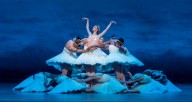UPDATE: The new seechicagodance.com will launch March 31st. Click here to learn more.
Joffrey’s 'Bolero': A new spin on familiar Ravel tune
It takes real gumption for a choreographer to tackle a piece of music as iconic as Maurice Ravel’s “Bolero,” but life has a way of re-informing the past with new context. The past year of unimaginable life-altering events may be the very catalyst choreographer and Joffrey Ballet dancer Yoshihisa Arai needed to inspire a new take on the familiar tune.
“Bolero” is Joffrey Ballet’s first performance since the COVID lock-down closed theaters last March. Arai’s “Bolero” began as a project for the Joffrey Academy and was subsequently slated for further development on the Joffrey Ballet. COVID restrictions put an early end to rehearsals for what was to be a live performance.
Reimagined as a digital performance piece for the first offering of Joffrey Ballet’s digital Salon Series, “Bolero” was put back into rehearsal in September and was pre-recorded at Joffrey Tower in the Gerald Arpino black-box theatre with The London Symphony Orchestra’s 2019 live concert recording.
An expression of the isolation, fear and uncertainty that have dominated our lives this past year, Arai’s “Bolero” embraces universal angst to which we can all relate. Part exorcism, part journey to a better tomorrow, “Bolero” casts solo dancer Anais Bueno as the shaman/surrogate for a Greek chorus of eight male and six female acolytes.
The pandemic is an invisible presence on stage. "Bolero's" 15 dancers never touch and they wear flesh-colored face masks. Joffrey dancer Temur Suluashvili costumed the bare-chested men in black traditional Japanese Kabuki pants, the women in flesh-colored leotards with black beaded-bib necklines and gauzy black skirts. Bueno stands out in a man’s white button-down dress-shirt over nude leotard and bare legs, commanding center stage for the entire 16 minute piece.
“Bolero” opens in silence, Bueno’s isolated face illuminated in a sea of darkness. She is unsettled, a hand searching the contours of her face, torso, arms and legs in what might be a caress. It is at once sensual and yet disturbing, almost as if she is trying to wipe something unpleasant off her body. The steady, rhythmic repetition of a snare drum begins quietly as the shadowy figures of other dancers begin to emerge from the darkness. She senses them but cannot touch them. A lone flute accompanies the foray of one long bare leg, the tendril of a vine seeking sustenance from the void until she is surrounded by a chorus of energized bodies, her acolytes.
Legs thrust out with flexed feet, then cave in, knock-kneed. Arms mimic hieroglyphics with right-angle elbows; hands rise and dip in geometric form; feet paddle a steady progression around her, then inch across the space in wide-leg heel-toe parallel progression. Bueno joins them briefly, then breaks away from their enclosure. She pioneers the space on a quest for freedom, leading them, alternating frenzied leaps with retreats into the crevices of her arms and legs.
The chorus’ leaps erupt like lightning around her. They tumble into dive rolls and hand stands, back flips and arching spines. They will do anything for her, if she would only purge the evil spirits keeping them apart. They celebrate her with mounting ecstasy to the surge of musical vitality that engulfs the stage.
Arai’s use of neoclassical lines, the suggestion of pagan ritual and the solo female supplicant recall Joffrey Ballet’s reconstruction of Nijinsky’s "The Rite Of Spring" (1913), first performed by the Joffrey Ballet in 1987 and revived in Chicago in 2013. In “Bolero,” Arai’s sacrificial maiden is not sacrificed. Rather, she is empowered, sensual and needy, fiercely determined to be the mistress of her own impulses. As in "Rite," however, she is an agent of purge and transformation for the community.
Ravel’s woodwinds, brass and strings build incrementally in the repeating melody’s compelling march toward full orchestration, augmenting in volume and layered instrumentation. The dancers’ repetitive movements mirror the music in augmenting range of motion and energy, encircling their shaman/priestess and propelling her to the climactic finale. In the shift from minor to major key and the roaring trombones just before the explosive finish, Bueno delivers herself to the edge of the stage. We expect her somehow to find release and freedom only to meet her uncertain gaze--hopeful perhaps, but not yet as triumphant as the march that has accompanied her journey into the void of an unknown future.
To his credit, Arai’s take on Ravel’s music is acutely sensitive to its structure and timbre and at the same time captures a visceral representation of the anguish of isolation and the loss of physical touch we have all experienced during the pandemic. His faithful adherence to the music suffers perhaps from over-fidelity to the repetitiveness of Ravel’s score. Even so, Arai brings a unique perspective to music that takes both gumption and determination to tackle, qualities we can all emulate during these challenging times.
--
Initially, “Bolero” was to air for one night only, Feb. 26, but has now been extended by popular demand through March 2. For more information, click the event page below.


